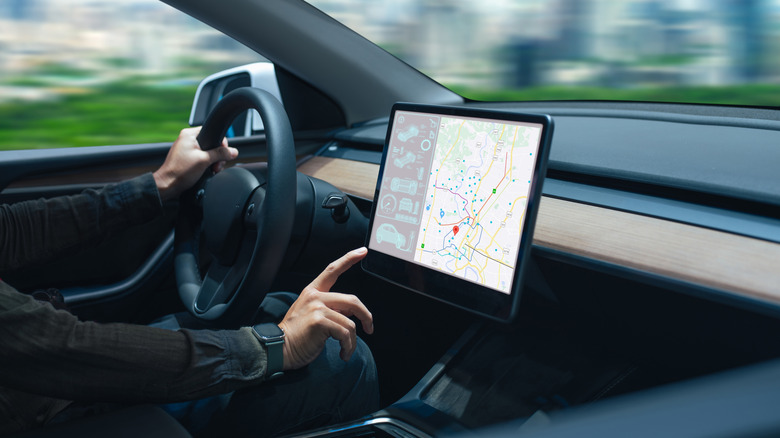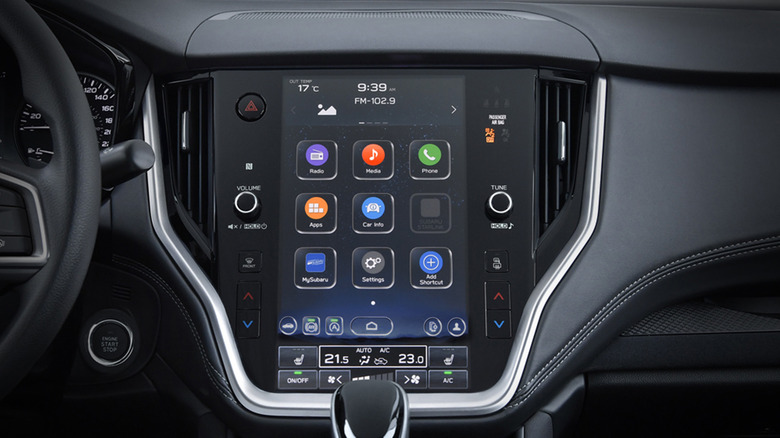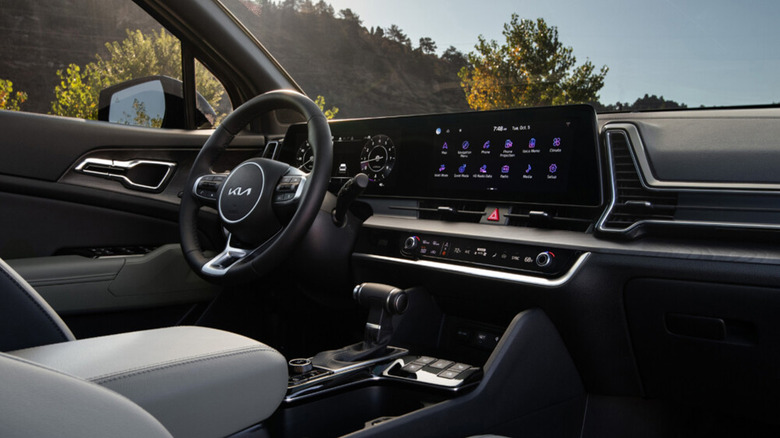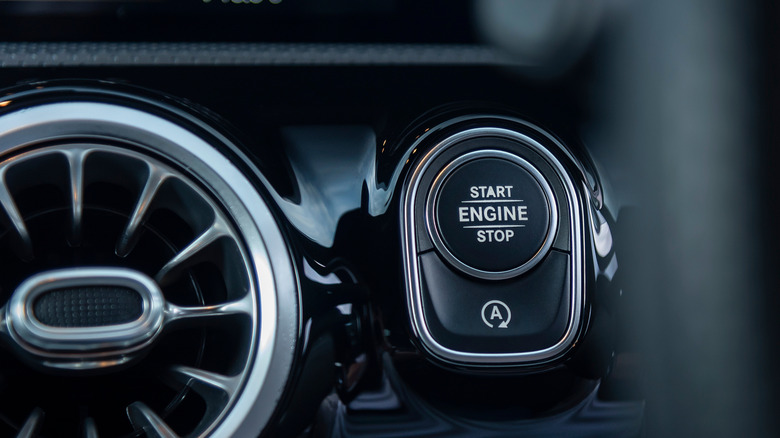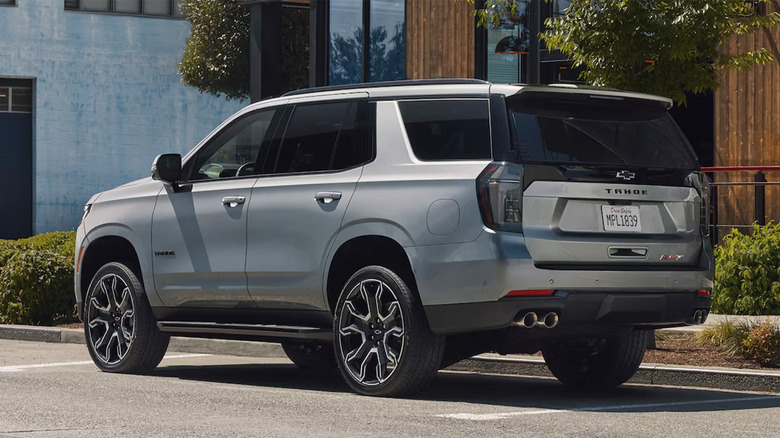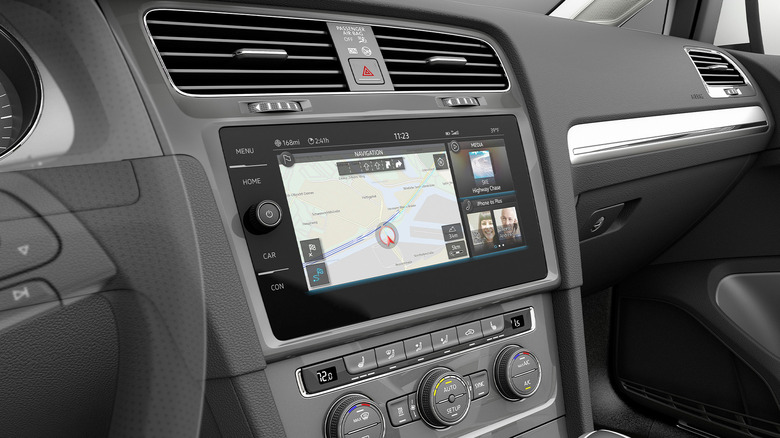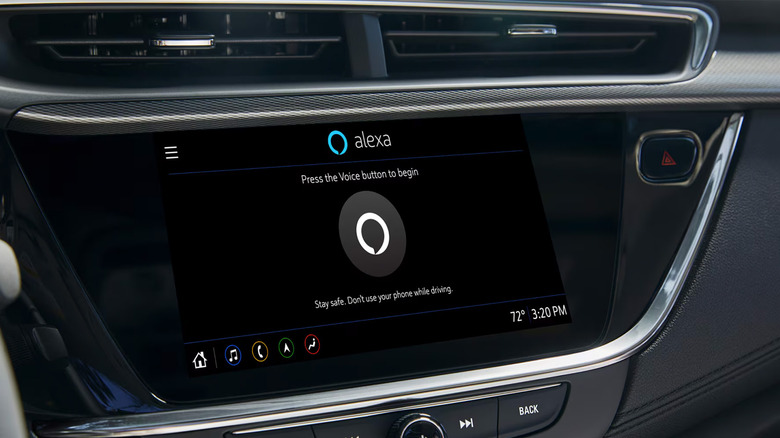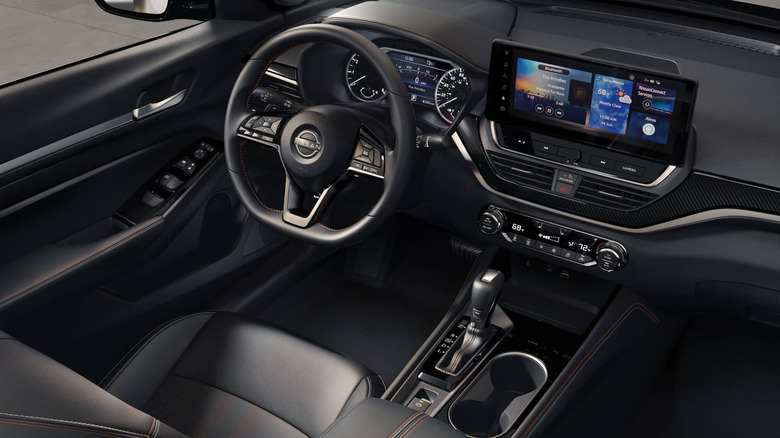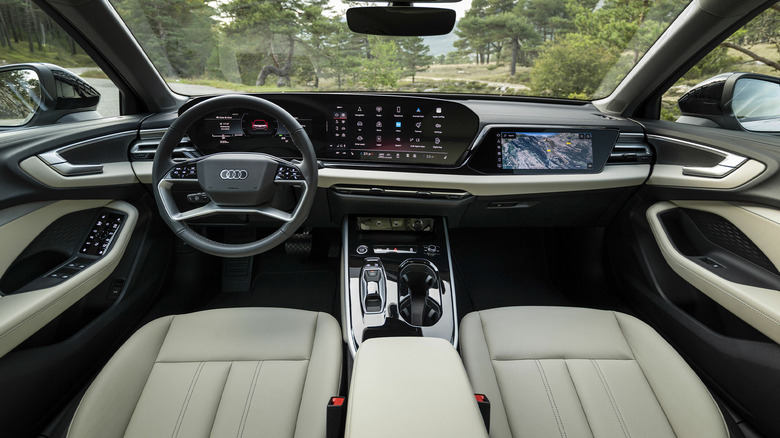10 Car Features To Avoid (And Why)
Generally, the more features your car has, the more enjoyable the experience tends to be. After all, few things feel better than a seat warmer on a cold winter day or, dare we say, seat ventilation on a warm summer evening. The same can be said with things like advanced driver aids and safety tech, which can help keep your car on the road and not wrapped around a tree. However, just because a car has more features doesn't necessarily make it better. In fact, some features can make a car worse.
There is some low hanging fruit here that we're going to bypass. For example, before 2023, air conditioning still wasn't a standard feature in every vehicle. Buying a car without AC is typically pretty awful, especially in most areas since heat waves have been getting hotter and longer in the U.S. lately. With that said, vehicles without AC tended to be niche vehicles anyway, such as off-roaders like the Jeep Wrangler or some sports cars. We're going to skip most of those obvious fringe use cases as they aren't something you'll run into every day when car shopping.
So, here are 10 automobile features that you don't really need and why you don't need them. There are some that could be on the list, such as ventilated seats. However, I will die on the hill that ventilated seats rule, and I think they should come standard on every vehicle. For the most part, we focused on features that could disappear tomorrow, and it wouldn't harm anyone.
Touchscreen climate controls
Vehicles have been putting a larger emphasis on the infotainment display over the last decade or so. They have been steadily getting bigger over the years, and it's estimated that the stock screen on a base vehicle will be around 10.6 inches by the year 2030. It makes sense. Screens can display a lot of useful information for the driver, like navigation. For media, at least, it's not a bad way to give users control, especially with the many tricks of Android Auto and Apple CarPlay along with the proliferation of music streaming.
One of the ways that automakers have been justifying the larger screen is by integrating climate controls into the infotainment as well. This is less good for a variety of reasons. For the most part, it's common sense. In my 2019 Honda Accord, I can turn the temperature down from 80 degrees to 60 degrees with a quick spin of a physical dial. On a touch control, I either have to take my eyes off the road to swipe the temperature down (likely multiple times) or tap the "temperature down" button on the screen 20 or so times to get the temperature I want. This is not only ergonomically terrible but also potentially dangerous.
The feedback has been so bad, in fact, that automakers have returned to physical controls. One notable example is Subaru, which brought back physical buttons and switches to its 2026 Outback SUV. Volkswagen made a similar decision last year and even called touchscreen climate controls a mistake.
Capacitive touch controls in general
While we're on the subject of bad ergonomics, capacitive buttons share touchscreen HVAC controls as being right up there among the worst trends in cars. Some automakers adopted the trend a lot faster than others. Volkswagen is known for embracing capacitive buttons on its center stack and steering wheel. Hyundai did the same with several of its vehicles, including the Hyundai Tucson, which featured a slab of capacitive controls underneath its infotainment display. Other automakers have jumped on the train to varying degrees over the years.
The issue with capacitive buttons is the same as putting climate controls in the infotainment. There is a distinctive lack of feedback compared to feeling for buttons, requiring the driver to take their eyes off the road. Plus, the lack of knobs and switches means you have repeat commands many times to get the settings you want. For example, in the Tucson, the fan strength controls have seven notches. So, if you want to go from the weakest fan setting to the strongest, you have to peck at the thing 7 times. Are more screens and fewer buttons really that safe?
Like climate controls in infotainment, automakers have started pulling it back. Volkswagen, Hyundai, and others have begun swearing off the fancy capacitive controls in favor of physical buttons, switches, and knobs. This trend may come back if humans ever get into self-driving cars when keeping one's eyes on the road is optional.
Auto start-stop that you can't disengage
Auto start and stop are one of those annoying car features we want gone. For those who may be unfamiliar, auto start and stop functionality is when your car shuts off completely and automatically when you come to a full stop and then it starts up again when you lift your foot off of the brake pedal. Is this bad for your engine? The technology actually does work, with most real-world tests showing a roughly 10% increase in overall fuel economy. Most vehicles come equipped with special equipment to handle it, reducing the risk of excessive wear from starting and stopping the engine repeatedly.
The thing is, implementations can be imperfect, and when you can't turn off the feature, it can quickly become an annoyance. There are two levels to this. The first is that some vehicles have rougher implementations, which can jerk the car and be generally uncomfortable to deal with. In addition, those imperfect implementations can cause other discomforts like turning off the AC when the car shuts down, which can be unappealing on hot days.
Some automakers, like Subaru, don't let you turn it off at all while others, like Chevy, do, but the settings reset every time you turn on your vehicle. Such decisions should warrant placement in automobile purgatory, especially when the implementation is bad. There are ways around it, like mods and devices that plug into your OBDII port. Still, having to spend money and mess around with electronics to kill a feature that should have an off switch doesn't feel good.
Hidden door handles
Hidden door handles aren't as common as some other features, but Tesla helped kickstart the trend and it's spread like the plague. They can work in various ways depending on their implementation. For Tesla, you press on one side of the door handle to pop it out and then you can open the car door. Mercedes-Benz has a fairly fancy design that automatically opens the door when it senses your approach. We get the appeal — it looks cool and makes the car look sleeker. However, it can also cause quite a lot of problems.
For starters, they are a pain to troubleshoot when they malfunction. Mercedes-Benz has a how-to video on if this happens and their best solution is to basically wedge something behind the door handle and pry it open. Hidden handles also have a tendency to freeze over during ice and snow conditions, leading frustrated people to carve their way into their car, assuming the handle itself isn't frozen. To be fair, some automakers like Tesla have solutions for this, but they're not obvious unless you know where to look.
Sure, none of these problems are so serious as to cause safety concerns, but they are annoying, and since this feature tends to only surface on the most expensive vehicles, it's an annoyance you're paying extra to get. They're definitely a better fit for people who live in warmer climates that don't get a lot of ice, but us northerners should probably stick to normal door handles for now.
Piano gloss black plastic interiors
Okay, so this one is more of an aesthetic design choice and not necessarily a feature. It is a design that people tend to pay more to get, though. For example, the Kia Sportage included piano gloss black plastic on the higher trims of its fourth-generation models. I know this from experience because I owned lower trim model, which included soft touch plastics while my wife got a top-end SX Turbo trim, which has piano black plastic. Regardless of where it came from, it's one of the worst interior design choices in the automotive industry.
At first, the sharp black contrast can look quite nice. Give it some time, though, and it'll eventually wind up looking smudged, worn, and ugly. Among the various materials that automakers use for interior decoration, none of them age quite as terribly as glossy black plastic. It scratches just by looking at it and it's supremely obvious when it starts to cake with dust. Unless you have a soft, low-abrasion cloth handy at all times, it's very difficult to keep glossy black plastic looking clean or new.
For the most part, consumers agree that glossy black plastic has only one purpose and that's to look nice on a brightly lit showroom floor. Kia removed it entirely from its EV9 and has used it noticeably less on some other vehicles as well. Hopefully other automakers follow suit so that the trend finally dies.
Cylinder deactivation
Cylinder deactivation — also known as variable displacement — is a technology that many modern car engines possess. The premise is pretty simple and, honestly, pretty cool. The idea is that the engine uses all of its cylinders when it needs the power, like during acceleration. Once you reach cruising speed, the engine deactivates a couple of its cylinders so that it consumes less fuel. As a "best of both worlds" type of solution, it's a neat idea on paper. Real world implementation, however, has left a little to be desired.
For starters, variable displacement engines tend to be less reliable than engines without this feature. The extra mechanical and electrical systems involved to turn off part of an engine add complexity, which means more moving parts to break. In addition, it has been observed that cylinder deactivation causes high oil consumption, which isn't good for an engine long-term. So, yes, you do get around 7.5% better fuel economy per the U.S. Department of Energy, but what you save at the pump may be spent on repairs.
The issues don't reduce with price, either. Mercedes-Benz recalled 26,200 of its sedans in 2024 due to cylinder deactivation issues. The Mazda 3, 6, and CX-5 were recalled for the same reason. Even reliability mainstays like Honda have had cylinder deactivation lawsuits. It's difficult to avoid these days but you should know what you're getting into if you get one.
Gesture controls
Gesture controls aren't the most common item in cars, but that is slowly changing. These days, you can find gesture control technology in a handful of automakers, including BMW, Jaguar, Mercedes-Benz, Volkswagen, and others. The premise is the same as on smartphones with gesture controls. You wave your hand around the cabin like a mad person and the car interprets the motions and performs an action. For the record, we are referring solely to in-cabin gestures here. The one where you can kick under your car and open your trunk is genuinely useful.
The list of reasons why this technology is useless is pretty common sense. For starters, the entire control structure of your car is designed specifically to be within arm's reach at all times. Automakers aren't always great at it, but even so, most of your controls are within arm's reach anyway, which means you don't need gesture controls for anything other than impressing passengers. Of course, like nearly all gesture controls, they also tend to be buggy. We found plenty of testimonials from car owners with gesture tech where they simply turned it off immediately after buying the car.
In fairness to automakers, gesture controls are super cool when they work properly. Being able to change the volume with a twirl of the finger certainly gives off the Iron Man vibe right alongside stuff like holograms and atmospheric detection. Sadly, the tech isn't there yet and should probably stay out of cars for a while longer.
Voice controls
As a car owner and tech nerd, I have made it a point to attempt to use the voice assistant in every car I've ever owned that had one. The premise is neat. You tell the car to do something, and the car does it. This is handier than gesture controls when it works since the commands can be so varied. After all, cars have been able to change their climate controls with voice prompts for years. When it works, there is nothing like it.
The key phrase in that last sentence was "when it works." It's true that some automobile makers have upped their game in recent years, but that is not the case for all of them. In general, voice assistants generally work pretty well. The issue is figuring out what to say and how to say it. Using natural language often doesn't work, especially in commodity brands like Honda. Instead of being able to tell your car to turn up the heat a few degrees, you have to be super precise, otherwise the system doesn't hear your commands. Thus, a genuinely useful feature becomes essentially pointless.
In my case, I hardly ever use my Honda Accord's voice controls unless it's hooked up to Android Auto. Having the power of Google — or Apple in the case of Apple CarPlay — dramatically increases the likelihood that my car understands what I ask it. GM opted to remedy the problem by integrating Amazon Alexa into its vehicles. That's probably for the best.
CVT transmissions with paddle shifters
Paddle shifters are becoming more and more common on automatic vehicles as a way to give partial control back to drivers in the increasing absence of manual transmissions. It's a feature you commonly see in race cars like Formula 1 and others. Instead of taking your hand off the wheel and shifting gears, you simply upshift and downshift using the right and left paddles tucked behind your steering wheel. They're useful in an automatic transmission car, especially for engine braking.
Automakers have also begun fitting paddle shifters in vehicles with CVTs. This feels counterintuitive because CVTs don't have gears to shift into. Instead, automakers fake it by making shift points at specific gear ratios. Thus, when you "upshift" in a CVT, it forces the transmission into that particular gear ratio. The premise is weird because CVTs are supposed to be able to variably change their ratios. That is, after all, what the "CV" part stands for — continuously variable. It seems silly to force a transmission with a nearly endless supply of gear ratios to set points just to emulate a different type of transmission.
There are valid reasons for having them. You can still use them to engine brake, for example. However, having paddle shifters functionally removes the reasons to own a CVT, which is the improved fuel economy and being able to avoid those jerky shifts of an automatic transmission. So, they can be useful, but not useful enough to specifically shop for this feature.
Small or poorly placed cup holders
Ah yes, the cup holder. Often forgotten in the rush to make interiors look stylish and cool. Some automakers definitely do these better than others and, admittedly, this is definitely something I took into account when buying my most recent vehicle. As a lover of Fiji water, I took a bottle to every test drive to make sure the center console could fit the square bottles. Some folks lament not taking that much care when shopping for a car.
The complaints here are wide and deep. Some cars, like the 2018 Audi A1, have small cup holders that can get in the way of manual shifting if the drink is large enough. The Ford Focus SVT barely even has any cupholders to speak of, and they're tucked way down between the front seats. Some cars don't have any cupholders at all, especially older ones. It seems like a small thing, but millions of people carry a soda or coffee into work every morning and need somewhere to put it. Conversely, the Hyundai Palisade has mammoth cup holders that don't work well for smaller drinks.
Some automakers do this quite well. Some variants of the Volkswagen Golf have adjustable cup holders to more snugly fit your drinks, which is awesome. My Honda Accord has excellent cup holders as well that fit a variety of drinks and don't get in the way. It's a small thing, but a good set of cupholders can definitely make life easier.
